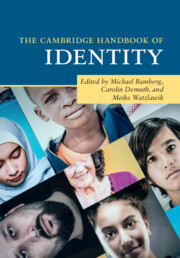15 results
Contributors
-
- Book:
- The Cambridge Handbook of Identity
- Published online:
- 29 October 2021
- Print publication:
- 11 November 2021, pp xi-xviii
-
- Chapter
- Export citation
28 - Where Is Identity? Reflections on Identity Conceptualizations, Dimensions, and Implications
- from Part V - Where Is Identity?
-
-
- Book:
- The Cambridge Handbook of Identity
- Published online:
- 29 October 2021
- Print publication:
- 11 November 2021, pp 629-639
-
- Chapter
- Export citation
Author Index
-
- Book:
- The Cambridge Handbook of Identity
- Published online:
- 29 October 2021
- Print publication:
- 11 November 2021, pp 640-640
-
- Chapter
- Export citation
1 - Identity: With or Without You?
-
-
- Book:
- The Cambridge Handbook of Identity
- Published online:
- 29 October 2021
- Print publication:
- 11 November 2021, pp 1-22
-
- Chapter
- Export citation
Figures
-
- Book:
- The Cambridge Handbook of Identity
- Published online:
- 29 October 2021
- Print publication:
- 11 November 2021, pp viii-ix
-
- Chapter
- Export citation
Contents
-
- Book:
- The Cambridge Handbook of Identity
- Published online:
- 29 October 2021
- Print publication:
- 11 November 2021, pp v-vii
-
- Chapter
- Export citation
Subject Index
-
- Book:
- The Cambridge Handbook of Identity
- Published online:
- 29 October 2021
- Print publication:
- 11 November 2021, pp 641-652
-
- Chapter
- Export citation
Tables
-
- Book:
- The Cambridge Handbook of Identity
- Published online:
- 29 October 2021
- Print publication:
- 11 November 2021, pp x-x
-
- Chapter
- Export citation
Copyright page
-
- Book:
- The Cambridge Handbook of Identity
- Published online:
- 29 October 2021
- Print publication:
- 11 November 2021, pp iv-iv
-
- Chapter
- Export citation
Part IV - Current Domains
-
- Book:
- The Cambridge Handbook of Identity
- Published online:
- 29 October 2021
- Print publication:
- 11 November 2021, pp 461-626
-
- Chapter
- Export citation
Part V - Where Is Identity?
-
- Book:
- The Cambridge Handbook of Identity
- Published online:
- 29 October 2021
- Print publication:
- 11 November 2021, pp 627-639
-
- Chapter
- Export citation
Part I - The Origin and Development of the Concept of Identity
-
- Book:
- The Cambridge Handbook of Identity
- Published online:
- 29 October 2021
- Print publication:
- 11 November 2021, pp 23-98
-
- Chapter
- Export citation
Part II - New Perspectives and Challenges
-
- Book:
- The Cambridge Handbook of Identity
- Published online:
- 29 October 2021
- Print publication:
- 11 November 2021, pp 99-238
-
- Chapter
- Export citation
Part III - Methodological Approaches
-
- Book:
- The Cambridge Handbook of Identity
- Published online:
- 29 October 2021
- Print publication:
- 11 November 2021, pp 239-460
-
- Chapter
- Export citation

The Cambridge Handbook of Identity
-
- Published online:
- 29 October 2021
- Print publication:
- 11 November 2021



